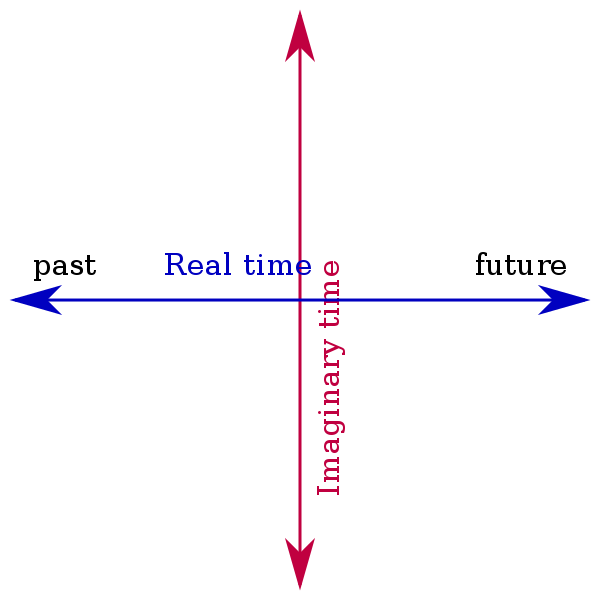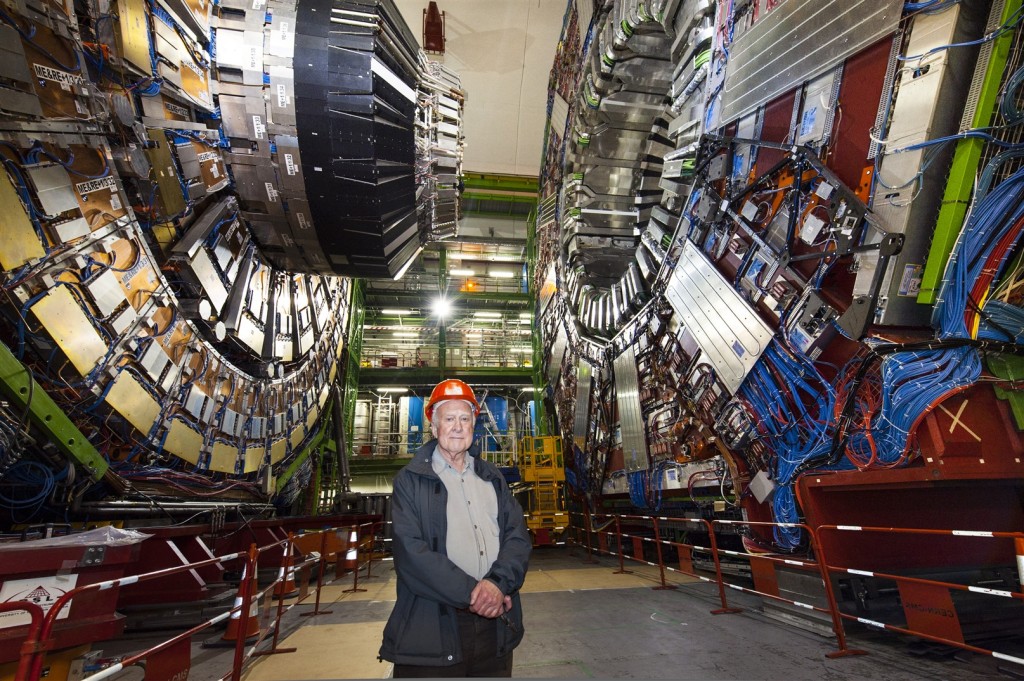
Update 14/03/2018 Professor Stephen Hawking died today. See his obituary here. From all I have read he remained an ardent atheist his whole life. And he never really understood the worldview issue in cosmology and the origin of the universe. This proves that even very smart people can get it wrong. Nevertheless he gave us much to ponder, debate and learn.
What is imaginary time? I don’t mean the time you spend day-dreaming but the concept in physics, promoted by theoretical physicist Stephen Hawking. It is used in some quantum mechanics and special relativity theory. Imaginary time is where the usual time dimension undergoes a Wick rotation (a phase rotation)1 so that its coordinates are multiplied by the imaginary number the square root of -1, represented by the symbol i. In such a situation time theoretically behaves like a spatial dimension.

Hawking wrote:2
“One might think this means that imaginary numbers are just a mathematical game having nothing to do with the real world. From the viewpoint of positivist philosophy, however, one cannot determine what is real. All one can do is find which mathematical models describe the universe we live in. It turns out that a mathematical model involving imaginary time predicts not only effects we have already observed but also effects we have not been able to measure yet nevertheless believe in for other reasons. So what is real and what is imaginary? Is the distinction just in our minds?” (emphasis added)
Positivism is the philosophy that we cannot determine what is real, but we can only propose hypotheses and test those against what we observe. Hawking is an atheist—an anti-theist—and has spent some time attempting to show that the Creator is unneeded in the universe.
Hawking claims that imaginary time is as real as real time, only that it is travelling in a different direction.3 He claims that ‘before’ the big bang time was imaginary and thus there was no time. Imaginary time may have “always existed” he said, but because we have no idea of what the laws of physics were ‘before’ the big bang, and there is no way to measure what happened ‘before’ the big bang, hence there is no point including time back then in a discussion of our universe.
On a program of National Geographic’s Star Talk show, Hawking told physicist Neil deGrasse Tyson,3
“In other words, there is no time before time began as time was always there. It was just different.”
He means that time was imaginary and not real. It behaved more like a spatial dimension. No real time existed and only the outcomes of some unknown quantum physics randomly selected what evolved. He said,
“… that amid the almost infinitely small quantum foam of the singularity before the Big Bang, time existed in a ‘bent’ state.
It was distorted along another dimension — always getting fractionally closer to, but never becoming, nothing.
So there never was a Big Bang that created something from nothing.
It’s just looks that way from our point of perspective.” 3
The single biggest problem with this speculation is that imaginary time or ‘bent’ time has never been observed in the cosmos. It therefore is simply outside the realm of physics because it cannot be observed. It is as practical as believing in fairies in the bottom of the garden.
However, Hawking admits that the universe had a beginning.
“All the evidence seems to indicate, that the universe has not existed forever, but that it had a beginning, about 15 billion years ago,” Hawking says in one of his lectures.4
“There must have been a beginning. Otherwise, the universe would be in a state of complete disorder by now, and everything would be at the same temperature. [This a statement about the Second Law of Thermodynamics] In an infinite and everlasting universe, every line of sight would end on the surface of a star. This would mean that the night sky would have been as bright as the surface of the Sun. The only way of avoiding this problem would be if, for some reason, the stars did not shine before a certain time.” (emphasis added)
Besides an eternal universe having a problem with disorder (2nd Law) he also argues that a finite age solves the problem of Olbers’ paradox, or why is the night sky black?5 That is true, but I want to focus on why.
Why is Hawking so focussed on this idea of imaginary time?
There are two problems he must overcome to eliminate the Creator God from the universe. One is the beginning in time and the second, related to that, is the creation of the mass/energy content of the universe from nothing.
He knows that nothing does not create a universe full of stars and galaxies (nothing creates nothing!). There must have been a First Cause. So, the way out of that is to say that the universe has always existed and what we observe today is the natural product of (unknown) laws of physics that existed ‘before’ the big bang. So, the big bang was a natural consequence of those laws, it didn’t create from nothing. Thus, the unknown laws of physics have become the new creator—an unknown god of the gaps.
Then there is the beginning of time problem. Now we do not subscribe to the 15-billion-year history he mentions, but the beginning of time is very biblical. That is the problem. The atheistic big bang believers must eliminate this beginning in time, else they’ll be accused again (as they were in the 1950s) of being “evangelical”. A beginning in time implies a First Cause, a Creator. For an atheist like Hawking, the Creator must be eliminated at all costs.
But he wants ‘to have his cake and eat it too’. He wants to have what appears to be a beginning for the universe at a finite time in the past, but because time ‘before’ the big bang was imaginary time, there really was no real beginning in time. Time just converted from imaginary time to real time; so from our perspective, as observers in the universe now, it appears that the 15 billion years since the big bang is all that there has been. Of course, the 15 billion years also is completely in contradiction to the biblical history, but that is another issue.
If you have an origin in time, you can argue that anything that exists, and had a beginning in time, also had to have a Creator.

This is the Kalām Cosmological Argument which has been used effectively for centuries to argue for a First Cause to the universe.
Now if the big bang cosmologist agrees the universe exists and began to exist at some moment in time past, then it also had to have had a cause–a first cause. That first cause can only have been an infinite Creator, who is greater than the universe itself.
Some long age/old earth Christian apologists, like W.L. Craig, use this argument, but based on the additional belief (premise) that the big bang was a real, scientifically provable historical event. That is a flawed approach, even though they use valid logic after that. Craig’s initial premise is not a fact (or cannot be proven to be a fact) and in such a case the rest of the argument fails.
But what would these apologists say when the secular big bang theorists continue to push towards the elimination of the origin in time, even the big bang as the beginning itself, as Hawking has tried to do? Others have proposed an eternal universe that eventually explodes in a big bang.6
Eliminate the need for the big bang to be the beginning in time and eventually they hope they can eliminate any need for the Creator Himself.
Quite obviously the universe did not create itself. For, in the beginning God created the universe (Genesis 1:1).
References and Notes
- A phase rotation mathematically is applied by multiplying the time axis t by i = eiπ/2 which means a phase angle of π/2. In special relativity a spacetime interval ds is represented by the quadratic sum of space (r) and time (t): ds2 = dr2 – c2.dt2 where c is the speed of light. This can be rewritten as ds2 = dr2 + c2. {eiπ/2dt}2. This leads to the notion that time behaves like an imaginary spatial dimension. So if time is rotated π/2 meaning t → i.t, it means imaginary time behaves like a spatial dimension. But it does not mean it has physical meaning.
- Hawking, S., The Universe in a Nutshell, Bantam Spectra, 2001.
- Seidel, J., Stephen Hawking argues time did not begin with the Big Bang. It was just going in a different direction, news.com.au, March 3, 2018
- Hawking, S., The beginning of time, www.hawking.org.uk/the-beginning-of-time.html, 2014.
- Hartnett, J.G., Why is the night sky black? January 25, 2016.
- Hartnett, J.G., An eternal big bang universe, February 26, 2015.
Recommended Reading
- Book: Apocalypse Now: On the Revelation of Jesus Christ
- Book: Merchants of Death: Global Oligarchs and Their War On Humanity
Follow me
- Telegram.org: @GideonHartnett
- Facebook: Gideon Hartnett
- X (Twitter): @gideon195203

To be notified by email put your email address in the box at the bottom of your screen. You’ll get an email each time we publish a new article.

Click this image to make a secure Donation (Stripe) !







One response to “Stephen Hawking and Imaginary Time”
Thanks for your quick posting. I was not surprised reading Hawking’s comments, and I got the sense that he is in a corner yet stubbornly trying to hold off. You’ve honed in on the antitheist issue.
LikeLike